U.S. Department of Transportation
Federal Highway Administration
1200 New Jersey Avenue, SE
Washington, DC 20590
202-366-4000
Federal Highway Administration Research and Technology
Coordinating, Developing, and Delivering Highway Transportation Innovations
|
R&T NOW This newsletter is an archived publication and may contain dated technical, contact, and link information. |
|
| Publication Number: N/A Date: July/August 2015 |
Publication Date: July/August 2015
|
PDF files can be viewed with the Acrobat® Reader®
NTSB Chair Visits Turner-Fairbank
On June 4, 2015, Chris Hart, Chairman of the National Transportation Safety Board (NTSB), and several managers and technical staff from NTSB visited FHWA’s Turner-Fairbank Highway Research Center (TFHRC). Chairman Hart was primarily interested in visiting laboratories at TFHRC that have assisted NTSB in its investigations or are associated with the Board’s priority agenda.
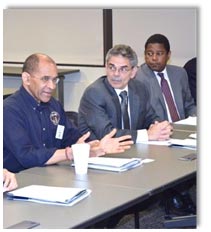 |
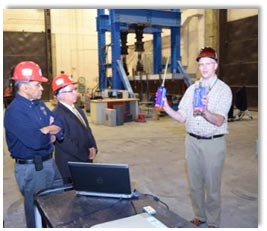 |
| On June 4, 2015, NTSB Chairman Chris Hart and several managers and technical staff from NTSB visited TFHRC. | |
These laboratories include:
For more information, contact Hiwot Abdi, 202-493-3999, hiwot.abdi@dot.gov.
New “R&T Story” Video Available on FHWA YouTube Channel
A video presentation, “The FHWA 2015 R&T Story,” is now available on FHWA’s YouTube Channel.
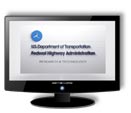
The short video offers a visual snapshot of how FHWA research and technology, conducted at TFHRC and in the field, plays an essential role in meeting the many demands of the Nation’s highway system and contributes to improvements in transportation safety, infrastructure, and operations.
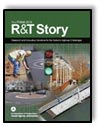
FHWA also recently published the print edition of “The FHWA 2015 R&T Story,” which highlights the value of research and how FHWA’s highway research and technology (R&T) initiatives are making a difference in addressing FHWA’s six key highway challenges:
To view “The FHWA 2015 R&T Story” video, visit https://youtu.be/M023cpmzQ6s. To read or download the printable version of “The FHWA 2015 R&T Story,” visit www.fhwa.dot.gov/publications/research/general/14091/14091.pdf.
Attendees from Transportation YOU Summit Tour Turner-Fairbank
On June 26, 2015, TFHRC hosted a tour for attendees of the Transportation YOU summit, a career exploration event for girls that offers programs and activities aimed at encouraging an interest in all modes of transportation. Over 50 individuals (mentors, mentees, and USDOT staff and volunteers) toured TFHRC’s Saxton Transportation Operations Laboratory, Human Factors Laboratory, Highway Safety Information System Workroom, and Geotechnical Laboratory.
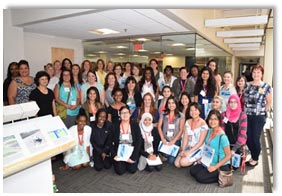
Transportation YOU summit attendees at TFHRC
The theme of this year’s summit was “Transportation and Technology.” Transportation YOU is a hands-on, interactive, mentoring program that offers 13- to 18-year-old girls an introduction to a wide variety of transportation careers. Through the program, chapters of the Women’s Transportation Seminar (WTS) provide girls with programs and activities designed to spark their interest in transportation and encourage them to take courses in math, science, and technology.
For more information about the tour, contact TaMara McCrae, 202-493-3382, tamara.mccrae@dot.gov. For more information about Transportation YOU, visit www.transportationyou.org/. For more information about WTS, visit https://www.wtsinternational.org/.
Turner-Fairbank Hosts Students for Transportation Summer Mini-Camp
Nearly 20 young high school and college students attended the second annual Transportation Summer Mini-Camp at TFHRC from June 30 to July 2, 2015.
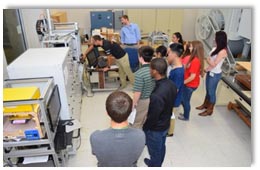
Students at TFHRC’s Transportation Summer Mini-Camp
This year’s participants learned about transportation research in the areas of safety, operations, and infrastructure through discussions with staff and learned first-hand how science, technology, engineering, and mathematics is applied through hands-on activities in several TFHRC laboratories.
For more information, contact David Yang, david.yang@dot.gov, 202-493-3284.
EAR Publishes RAP Catalog
FHWA’s Exploratory Advanced Research (EAR) Program, which addresses the need for longer-term, higher-risk research with potential for long-term improvements to transportation systems, has just published the first edition of its Research Associate Program catalog. FHWA has participated in the National Research Council Research Associateship Program (RAP) since 1992. To supplement the expertise of permanent staff, TFHRC, through the EAR Program, invites researchers with appropriate backgrounds to investigate specific problems on a short-term basis across a wide range of topics and disciplines.
RAP provides opportunities for the EAR Program to advance research methods used at TFHRC in such areas as nano-additives for concrete and asphalt, alternative intersection and interchange design, and modeling to predict collisions based on driver behavior and environmental conditions. The catalog, “Exploratory Advanced Research Program Research Associates Program 2014,” provides a summary of some of the research projects that resident fellows have been involved in during their tenures at FHWA.
The document is available at www.fhwa.dot.gov/advancedresearch/pubs/15031/index.cfm.
For more information about the EAR Program, contact David Kuehn, 202-493-3414, david.kuehn@dot.gov.
Video Analytics Opens the Way to Managing Large Data Files
The EAR Program has just published a catalog consolidating 3 years of its video analytics research to make data processing and analysis more practical by focusing on increasing the automation of video data decoding. The Transportation Research Board’s Second Strategic Highway Research Program (SHRP2) study demonstrates the immense scale of data being gathered. The flagship dataset to emerge from the SHRP2 Program is the naturalistic driving study, which includes over a million hours of video data from inside and outside regular passenger vehicles in normal day-to-day use. The study is designed to improve understanding of the interaction of various factors involved in highway crashes—driver, vehicle, and infrastructure—so that better safety countermeasures can be developed and applied to save lives.
The goal of these EAR Program projects is to assist researchers through the use of an algorithm designed to narrow down the amount of data researchers need to manually review. This will enable researchers to quickly and accurately extract the required details from large data files. There are six ongoing video analytics projects funded by the EAR Program, all tasked with developing technology to make it feasible for researchers to quickly and flexibly get what they need from an extremely large dataset.

Hands on steering wheel segmentation
The catalog covers the initial research on machine learning that was awarded to Carnegie Mellon University (CMU) in 2012; three additional research projects awarded to SRI International, CMU, and the University of Wisconsin-Madison in 2014 on lessons learned from the initial research; two additional research awards to CMU and SRI International to investigate automated identity masking; and a benchmarking research progress project awarded to the Department of Energy’s Oak Ridge National Laboratory to develop tools for benchmarking research progress.
Transportation researchers are starting to use extremely large datasets to identify and understand complex transportation issues that can impact transportation efficiency, cost, and safety. New automated tools for data extraction and analysis will help make these massive datasets accessible to the widest possible range of researchers, dramatically reducing the cost and time it takes to process raw data.
The catalog is available at www.fhwa.dot.gov/advancedresearch/pubs/15025/index.cfm.
For more information about the EAR Program, contact David Kuehn, 202-493-3414, david.kuehn@dot.gov.
Reference Scan on Behavioral Economics and Transportation Available on EAR Web site
An initial stage reference focused on behavioral economics and transportation safety is available on the EAR Program’s Web site: www.fhwa.dot.gov/advancedresearch/pubs/15035/index.cfm. The scan identifies published literature between 2012 and 2013. This investigation is a first step in the EAR Program process for exploring ideas across traditional and nontraditional fields of research and stimulating new approaches to problem solving. The literature review and reference scan allows for a better understanding of active research in a particular topic area. The scan also contributes to the process of identifying priorities and opportunities for strategic investment in further research. The EAR Program reference librarian uses various selection criteria, such as authority, relevance, and timelines, and scans information that has not been published, such as presentations, papers, and grant awards. Each year the EAR Program explores 20 or more topics.
For more information about the Federal Highway Administration Research Library, visit www.fhwa.dot.gov/research/library/index.cfm. For more information about the EAR Program, visit www.fhwa.dot.gov/advancedresearch/about.cfm.
Pavement Materials Team Hosts Meeting for TPF Project
On June 2, 2015, FHWA’s Pavement Materials Team in the Office of Infrastructure Research and Development (R&D) hosted a meeting at TFHRC to discuss the transportation pooled fund (TPF) project, “Standardizing Lightweight Deflectometer Measurements for Quality Assurance and Modulus Determination in Unbound Bases and Subgrades.” The meeting brought together TPF representatives from departments of transportation in Indiana, Maryland, Michigan, Minnesota, New York, South Carolina, and Virginia, as well as professionals from FHWA’s DelMar Division and Baltimore Resource Center, Kessler Soils Engineering Products, Inc., and the University of Maryland. The main purpose of the meeting was to coordinate research that will be conducted at the large-scale outdoor laboratory at TFHRC’s Pavement Test Facility. Attendees toured the pavement and geotechnical laboratories.
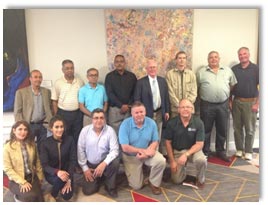
FHWA’s Pavement Materials Team hosted a meeting
to discuss a transportation pooled fund project.
The goal of the research is to develop stiffness-based technologies for quality control and acceptance of highway materials during construction of embankments, asphalt, and pavement base or subgrade layers specifications. Current practice for compaction control involves using the nuclear density gage. However, these devices have a significant time and cost overhead for upkeep, security, and training for both agencies and contractors. The profession has been moving away from conventional density-based construction and placing more focus on implementing modulus or stiffness-based construction because these more fundamental engineering properties have a more direct influence on pavement design and performance.
The TPF project seeks to replace nuclear density gauges with portable lightweight deflectometer instruments that measure stiffness and modulus directly. There is currently no widely recognized standard for interpreting the load and deflection data obtained during construction quality assurance testing and relating these measurements to the elastic modulus values used in pavement design. This research is expected to provide a straightforward procedure that can be employed by inspection personnel.
For more information, contact Charles Schwartz, the principal investigator for the project, at 301-405-1962 or schwartz@umd.edu.
FHWA Brings New Safety Technology to the United States
Higher friction can help a vehicle stop or maneuver its way out of a crash. In a project funded by FHWA, the first Sideway-force Coefficient Routine Investigation Machine (SCRIM) in the United States will assist States in using the American Association of State Highway and Transportation Officials (AASHTO) Pavement Friction Management Guide. The instrumentation is housed in an orange Volvo truck owned by FHWA.
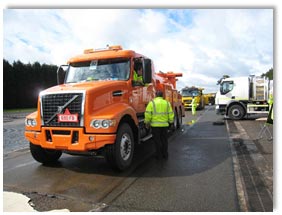
FHWA’s orange Sideway-force Coefficient
Routine Investigation Machine
The truck will be driven thousands of miles through Florida, Indiana, Texas, and Washington collecting data. FHWA awarded the Virginia Tech Transportation Institute (VTTI) a contract to use the SCRIM to continuously measure friction, cross-slope, macro-texture, grade, temperature, and curvature while being driven up to 50 miles per hour in these four States. The vehicle, which arrived in the United States at the end of May 2015, is being testing on VTTI’s Smart Road.
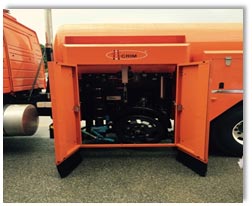
Free rolling testing wheel
Various measurements will be cross-referenced with crash data for developing pavement friction management programs. This data is expected to advance development of friction demand categories and set thresholds to identify road segments to investigate for remedial measures before crashes occur. The current practice of most States is to use a locked wheel skid trailer that spot checks about every 500 feet.
For more information, contact Katherine Petros, 202-493-3154, katherine.petros@dot.gov.
OGA Research to Advance Higher Friction Angles for Structural Backfills
FHWA recently published the report, “Strength Characterization of Open-Graded Aggregates for Structural Backfills” (FHWA-HRT-15-034), which discusses a study focused on establishing a knowledge base of the most commonly used American Association of State Highway and Transportation Officials (AASHTO) open-graded aggregates (OGA).
State and local transportation agencies frequently use crushed, manufactured open-graded aggregates as structural backfill material for retaining walls, bridge foundations, and other ground improvement applications, yet their strength characteristics are not fully understood or applied. To address this gap, researchers began a study at TFHRC that included a systematic approach to fully characterize the strength parameters utilizing the large scale direct shear and triaxial devices in the Geotechnical Laboratory. Researchers also investigated relationships between other important soil parameters on the friction angle, as well as the impact of different automated testing devices and data interpretation methods.
This report presents the results of this research and is expected to assist State and local transportation agencies, researchers, and design consultants in gaining confidence on the use of higher friction angles for structural backfills to optimize the design of geotechnical features. The document is available to download at www.fhwa.dot.gov/publications/research/infrastructure/structures/bridge/15034/.
For more information, contact Jennifer Nicks, 202-493-3075, jennifer.nicks@dot.gov.
GRS-IBS Guidance Helps Ohkay Owingeh Pueblo Construct Bridge
Thanks to FHWA’s guidance, the Ohkay Owingeh Pueblo in New Mexico can now construct bridges using the Geosynthetic Reinforced Soil Integrated Bridge System (GRS-IBS), an innovation supported by FHWA under Every Day Counts (EDC), the agency’s partnership with States and localities to encourage the use of technologies, approaches, and project delivery methods that save time, save money, and save lives. Assisted by Tribal Transportation Program funds and a $200,000 Accelerated Innovation Deployment Demonstration grant, the pueblo is putting its own people to work to replace a 60-foot bridge. To prepare for the Every Day Counts deployment, they worked with the Office of Federal Lands, studied FHWA GRS-IBS guidance, and attended the Kaw Nation/Kay County GRS-IBS Showcase in Blackwell, OK last year. Equipped with newly learned construction skills, the pueblo is now at the cutting edge of technology for replacing small structures across its land.
To learn more about GRS-IBS, visit www.fhwa.dot.gov/everydaycounts/technology/grs_ibs/index.cfm.For more information, contact Mike Adams, 202-493-3025, mike.adams@dot.gov.
ELCSI Pooled Fund Study Holds Eleventh Annual Meeting
On June 2 and 3, 2015, representatives of 38 State departments of transportation participated in the Eleventh Annual Technical Advisory Committee (TAC) meeting for the Evaluation of Low Cost Safety Improvements Pooled Fund Study (ELCSI-PFS) at TFHRC. The objective of the meeting was for State representative members to receive progress updates for ongoing phases of the study, learn about other current and upcoming safety efforts at State and Federal levels, exchange information and ideas with peers, conduct technology transfer, and cast ballots identifying high priority safety strategies for future studies.
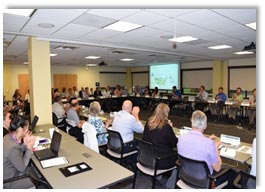
TAC meeting for the Evaluation of Low
Cost Safety Improvements Pooled Fund Study
Since its inception in 2005, this pooled fund study has evaluated the safety effectiveness of more than 45 of the low-cost safety improvements listed as priority strategies in the National Cooperative Highway Research Program Report 500 Guides. Crash Modification Factors (CMFs) for each evaluation are developed and will be posted at the CMF Clearinghouse, administered by FHWA’s Office of Safety and Highway Safety Manual. Research is currently underway to evaluate an additional 18 low-cost safety improvements, including pedestrian countdown signals and a combination of median barrier and rumble strips. Membership in this pooled fund study has steadily grown and funding has increased from $2.8 million to $3.6 million in State commitments and from $1.5 million to $2.5 million in FHWA contributions.
To access the CMF Clearinghouse, visit www.cmfclearinghouse.org/.
For more information, contact Roya Amjadi, 202-493-3383, roya.amjadi@dot.gov.
Report Documents Factors Affecting Speed and Safety, Describes Treatments
FHWA recently published the report, “Factors Influencing Operating Speeds and Safety on Rural and Suburban Roads” (FHWA-HRT-15-030), which documents component factors affecting speed and safety on rural and suburban roadways that are not limited access and describes treatments that have the potential to reduce speed-related crashes. Drivers who exceed the speed limit or drive too fast for the conditions are involved in nearly one-third of all fatal crashes. Over 13,000 people are killed in speeding-related crashes each year. The first phase of the study included a review of literature on design features and current practices associated with safer operating speeds and identification of treatments for field evaluations. The second phase involved evaluating treatments to determine their effectiveness in reducing speeds on two-lane horizontal curves in rural and suburban areas.
This report is available to download at www.fhwa.dot.gov/publications/research/safety/15030/.
Saxton Lab Demonstrates Nation’s First Automated Eco-Friendly Cruise Control
Together with its partners, FHWA’s Saxton Transportation Operations Laboratory has implemented and successfully demonstrated the Nation’s first application of a cooperative adaptive cruise control that automatically communicates wirelessly with a traffic signal and controls a vehicle’s approaching and departing speed in an eco-friendly manner. The technology can potentially save approximately 20 percent in fuel. The Saxton Transportation Operations Laboratory successfully outfitted a Ford Escape hybrid vehicle with a robotic speed controller, an onboard computer, high-precision location equipment (an augmented global position system), and a dedicated short range communication (DSRC) unit. FHWA Office of Operations R&D staff, in cooperation with partners, built onboard application and control software that provides a tablet-based driver interface and computes an optimum speed trajectory through TFHRC’s intelligent intersection. Upon computing this trajectory and activation by the driver, the software takes control of the vehicle’s accelerator and brakes to safely and smoothly drive it through the intersection while respecting the traffic signal and local speed limit. Just as with any cruise control, the human driver is always in control of the vehicle and can disengage the automation by stepping on the brake or turning the cruise control feature off.
FHWA’s pioneering work has established a solid foundation for continued research and invention involving variable signal timing, accommodating other vehicles in the intersection, and investigating multisignal applications. This work is part of FHWA’s Office of Operations R&D’s mission and is jointly funded by FHWA’s EAR Program, Office of Operations, and the Intelligent Transportation Systems (ITS) Joint Program Office’s Program: Applications for the Environment: Real-time Information Systems. This project will also continue through the Crash Avoidance Metrics Partnership, a consortium of 12 vehicle manufacturers who will first further investigate the feasibility of this application and then conduct a small scale prototype/test for possible commercial deployment in the future.
For more information, contact Osman Altan at osman.altan@dot.gov.
Web Portals Demonstrated at USDOT Data Palooza
On June 16 and 17, 2015, the Intelligent Transportation Systems (ITS) Joint Program Office, FHWA’s Office of Operations, and FHWA’s Office of Operations R&D demonstrated ITS related applications and data available to use on the Open Source Application Development Portal (OSADP) and Research Data Exchange (RDE). The demonstrations highlighted the software, computer code, and data available to use when conducting research, developing, testing, evaluating, and planning for applications that may include connected vehicle, mobile devices, travelers, and weather conditions.
The OSADP and RDE are Web portals that enable usage of open source software, computer code, and data for deployment-ready ITS related applications. Users can also collaborate on the development of the software, computer code, and data. A high-level overview of the ITS Data Capture Management Program and its six program tracks was provided during the Data Palooza. Team members displayed and discussed the evaluation approach, current status (including RDE analytics graphs and charts), and elements from the executive dashboard.
For more information, contact Jon Obenberger, 202-493-3265, jon.obenberger@dot.gov.
University Researchers Spending Summer On Lane Change/Merge Weave Project
Saxton lab is hosting a team of researchers this summer from Auburn University, Ohio State University, and the University of California, Riverside. The researchers are participating in foundational research on lane change/merge maneuvering in vehicles with automated longitudinal control. The objective of this project is to obtain a basic, experimental understanding of the needs and methodologies for performing automated lane change/merge maneuvers. The research team, with FHWA guidance, is developing a “Vehicle Maneuvering Ideas/Concepts Matrix,” in which they define concepts for lane change/merge (i.e., scenarios, use cases, etc.); develop hypotheses for each concept; determine the hardware, software, and data needs for each concept; and evaluate the concept by quantifying its impacts on traffic throughput, safety, and fuel consumption. As a demonstration of collaboration and knowledge of the field, the faculty and students from the three universities have jointly coauthored and submitted a survey article on these topics for peer review and publication in the Institute of Electrical and Electronics Engineers’ Transactions on Intelligent Transportation Systems. In addition, the team is developing and simulating algorithms for lane change/merge. These algorithms will be implemented and tested on two of FHWA’s research vehicles at TFHRC.
For more information, contact Dan Dailey at daniel.dailey.ctr@dot.gov.
Strategic Freight R&D Plan Development Underway
In response to the direction and support of FHWA’s Office of Operations, FHWA’s Office of Operations R&D has asked the Volpe National Transportation Systems Center (Volpe) to help deliver a first Strategic Freight R&D Plan for FHWA. The plan will be developed in coordination with FHWA’s Office of Freight Management and Operations, Resource Center, Division Offices, Office of the Secretary of Transportation-Research and Technology, and TFHRC’s offices. The Office of Operations R&D will serve as convener of the stakeholders. Volpe will provide expertise relevant to all phases of work leading to delivery of the plan.
Tasks will include conducting joint workshops with the Office of Freight Management and Operations, the Intelligent Transportation Systems Joint Program Office, and the Resource Center to baseline the current state of the art and practice, including a common definition of “R&D,” as well as a review of current freight operations R&D activities and needs for the future. It will also involve gathering input on freight operations R&D activities and needs from FHWA Division Offices, Transportation Research Board (TRB) Committees, and relevant private sector research programs. The final Strategic Freight R&D Plan will include a well-defined package of mission, vision, goals, and objectives for FHWA freight operations R&D, as well as recommended tactical actions, processes, and the associated roles and responsibilities to implement them.
For more information, contact Joe Peters at joe.peters@dot.gov.
Automated Vehicles Symposium 2015
Research team members from FHWA’s Office of Operations R&D will present the latest advances in their research at the Automated Vehicles Symposium 2015 in Ann Arbor, MI. The event, which is jointly sponsored by the Association for Unmanned Vehicle Systems International and TRB, is a “multidisciplinary forum designed to advance the deployment of automated vehicles.” The symposium features high-level presentations by innovators in the field as well as interactive breakout sessions. FHWA’s Office of Operations R&D will lead a series of breakout sessions on early deployment opportunities for connected automated vehicles.
To learn more, visit the symposium’s Web site, www.automatedvehiclessymposium.org/home, or contact Bob Ferlis at robert.ferlis@dot.gov.
Public Roads—May/June 2015
This issue includes: Let’s Ride!; Smooth Operators; Partners Across the Pacific; On the Road with Ike and Niki; A Pivotal Job for Police; and Advancing the Triple Bottom Line.
It is available online via www.fhwa.dot.gov/publications/publicroads/15mayjun/index.cfm.
For more information, contact TaMara McCrae, tamara.mccrae@dot.gov.
Innovator: Accelerating Innovation for the American Driving Experience—July/August 2015
This issue includes: Success Stories Show Value of First Responder Training; Smarter Work Zones; STIC Best Practices; Improving DOT and Railroad Coordination; Multistate Programmatic Consultation Streamlines Bat Conservation Efforts; States Innovate!; and Events.
The issue is available online via www.fhwa.dot.gov/hfl/innovator/e-version/issue_49/.
Turner-Fairbank Highway Research Center: www.fhwa.dot.gov/research/tfhrc/
Resource Center: www.fhwa.dot.gov/resourcecenter/
National Highway Institute: www.nhi.fhwa.dot.gov/home.aspx
Please forward this newsletter to others you think might find it interesting and/or useful.
Suggestions may be submitted to: FHWA_Now@fhwa.dot.gov